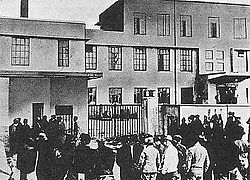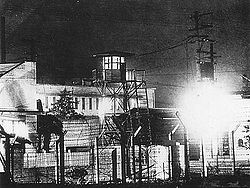
Sugamo Prison
Encyclopedia


Ikebukuro
is a commercial and entertainment district in Toshima, Tokyo, Japan. Toshima ward offices, Ikebukuro station, and several shops, restaurants, and enormous department stores are located within city limits....
, which is now part of the Toshima
Toshima, Tokyo (ward)
is one of the 23 Special wards of Tokyo, Japan. Toshima is one of the eight central wards of the Tokyo Metropolitan area, including Chiyoda, Minato, Shibuya, Chuo, Shinjuku, Taito, and Bunkyo surrounding the Imperial Palace...
ward of Tokyo
Tokyo
, ; officially , is one of the 47 prefectures of Japan. Tokyo is the capital of Japan, the center of the Greater Tokyo Area, and the largest metropolitan area of Japan. It is the seat of the Japanese government and the Imperial Palace, and the home of the Japanese Imperial Family...
, Japan
Japan
Japan is an island nation in East Asia. Located in the Pacific Ocean, it lies to the east of the Sea of Japan, China, North Korea, South Korea and Russia, stretching from the Sea of Okhotsk in the north to the East China Sea and Taiwan in the south...
History
Sugamo Prison was originally built in the 1920s for political prisonerPolitical prisoner
According to the Longman Dictionary of Contemporary English, a political prisoner is ‘someone who is in prison because they have opposed or criticized the government of their own country’....
s, using the prisons of Europe
Europe
Europe is, by convention, one of the world's seven continents. Comprising the westernmost peninsula of Eurasia, Europe is generally 'divided' from Asia to its east by the watershed divides of the Ural and Caucasus Mountains, the Ural River, the Caspian and Black Seas, and the waterways connecting...
as a model. It housed many communists
Communism
Communism is a social, political and economic ideology that aims at the establishment of a classless, moneyless, revolutionary and stateless socialist society structured upon common ownership of the means of production...
and other dissenters who fell afoul of the Peace Preservation Law
Peace Preservation Law
The Public Security Preservation Laws were a series of laws enacted during the Empire of Japan. Collectively, the laws were designed to suppress political dissent.-the Safety Preservation Law of 1894:...
s in the 1930s and 1940s. The Allied spies were also incarcerated there, including Richard Sorge
Richard Sorge
Richard Sorge was a German communist and spy who worked for the Soviet Union. He has gained great fame among espionage enthusiasts for his intelligence gathering during World War II. He worked as a journalist in both Germany and Japan, where he was imprisoned for spying and eventually hanged....
who was hanged in the prison on November 7, 1944.
The prison was not damaged during the bombing of Tokyo
Bombing of Tokyo in World War II
The bombing of Tokyo, often referred to as a "firebombing", was conducted by the United States Army Air Forces during the Pacific campaigns of World War II. The U.S. mounted a small-scale raid on Tokyo in April 1942, with large morale effects...
during World War II
World War II
World War II, or the Second World War , was a global conflict lasting from 1939 to 1945, involving most of the world's nations—including all of the great powers—eventually forming two opposing military alliances: the Allies and the Axis...
, and the Allied occupation forces
Supreme Commander of the Allied Powers
Supreme Commander of the Allied Powers was the title held by General Douglas MacArthur during the Occupation of Japan following World War II...
took it over during the occupation of Japan
Occupied Japan
At the end of World War II, Japan was occupied by the Allied Powers, led by the United States with contributions also from Australia, India, New Zealand and the United Kingdom. This foreign presence marked the first time in its history that the island nation had been occupied by a foreign power...
to house suspected war criminals as they awaited trial before the International Military Tribunal for the Far East
International Military Tribunal for the Far East
The International Military Tribunal for the Far East , also known as the Tokyo Trials, the Tokyo War Crimes Tribunal, or simply the Tribunal, was convened on April 29, 1946, to try the leaders of the Empire of Japan for three types of crimes: "Class A" crimes were reserved for those who...
. After the conclusion of the trials, Sugamo Prison was used to incarcerate some of the convicted and was the site of the execution of seven inmates those sentenced to death
Death Sentence
Death Sentence is a short story by the American science-fiction writer Isaac Asimov. It was first published in the November 1943 issue of Astounding Science Fiction and reprinted in the 1972 collection The Early Asimov.-Plot summary:...
by hanging
Hanging
Hanging is the lethal suspension of a person by a ligature. The Oxford English Dictionary states that hanging in this sense is "specifically to put to death by suspension by the neck", though it formerly also referred to crucifixion and death by impalement in which the body would remain...
on December 23, 1948.
The original compound was only 2.43 hectare
Hectare
The hectare is a metric unit of area defined as 10,000 square metres , and primarily used in the measurement of land. In 1795, when the metric system was introduced, the are was defined as being 100 square metres and the hectare was thus 100 ares or 1/100 km2...
s (approximately 6 acre
Acre
The acre is a unit of area in a number of different systems, including the imperial and U.S. customary systems. The most commonly used acres today are the international acre and, in the United States, the survey acre. The most common use of the acre is to measure tracts of land.The acre is related...
s) in size. The construction of exterior fencing expanded the facility to double the original size. The facility was operated by the United States Army
United States Army
The United States Army is the main branch of the United States Armed Forces responsible for land-based military operations. It is the largest and oldest established branch of the U.S. military, and is one of seven U.S. uniformed services...
's Eighth Army, although the actual operation of the prison was handled by Japanese personnel. There were approximately 2500 military personnel assigned to duty at the prison, however no more than 500 at any given time. The prison was only in operation by American military forces from December 1945 through May 1952. The structure housed some 2000 Japanese war criminals during its operation.
The prisoners ate Japanese food prepared by Japanese personnel and served by the prisoners themselves. There were occasions when former Prime Minister
Prime Minister of Japan
The is the head of government of Japan. He is appointed by the Emperor of Japan after being designated by the Diet from among its members, and must enjoy the confidence of the House of Representatives to remain in office...
Hideki Tojo
Hideki Tōjō
Hideki Tōjō was a general of the Imperial Japanese Army , the leader of the Taisei Yokusankai, and the 40th Prime Minister of Japan during most of World War II, from 17 October 1941 to 22 July 1944...
served food to all the other class "A" prisoners. Some of the vegetables used in these meals were grown within the compound.
After the end of the occupation of Japan, Sugamo Prison passed to Japanese civilian government control. Most of the remaining war criminals were pardoned or paroled by the government. In 1971 the prison was closed due to the age of the facilities.
In 1978 the Sunshine 60
Sunshine 60
is a 60-story, mixed-use skyscraper located in Ikebukuro, Toshima, Tokyo, adjoining the Sunshine City complex. At the time of its completion in 1978, the 239.7 m building was the tallest in Asia, a title it held until 1985 when it was surpassed by the 63 Building in Seoul...
Building, at its completion the tallest skyscraper
Skyscraper
A skyscraper is a tall, continuously habitable building of many stories, often designed for office and commercial use. There is no official definition or height above which a building may be classified as a skyscraper...
in Japan, was built on the former site of Sugamo Prison. All that is left to commemorate the prison is a stone on which is engraved, in Japanese, "Pray for Eternal Peace."

